airbag off Seat Exeo ST 2011 Owner's manual
[x] Cancel search | Manufacturer: SEAT, Model Year: 2011, Model line: Exeo ST, Model: Seat Exeo ST 2011Pages: 319, PDF Size: 5.12 MB
Page 24 of 319

22Seat belts
Seat belt protection
Passengers not wearing seat belts risk severe injuries in the
event of an accident.
Fig. 10 A driver wearing
the seat belt properly is
secured by the belt in
sharp braking
Properly worn seat belts hold the vehicle occupants in the correct sitting po-
sitions and substantially reduce the kinetic energy in the event of an acci-
dent. Seat belts also help to prevent uncontrolled movements that could
lead to severe injuries. In addition, properly worn seat belts reduce the dan-
ger of being thrown from the vehicle.
Passengers wearing their seat belts correctly benefit greatly from the ability
of the belts to absorb kinetic energy. The front part of your vehicle and other
passive safety features (such as the airbag system) are also designed to ab-
sorb the kinetic energy released in a collision. Taken together, all these fea-
tures reduce the releasing kinetic energy and consequently, the risk of in-
jury.
Our examples describe frontal collisions. Of course, properly worn seat belts
substantially reduce the risk of injury in all other types of accidents. This is
why it is so important to fasten seat belts before every trip, even when "just
driving around the corner". Ensure that your passengers wear their seat belts as well. Accident statistics
have shown that wearing seat belts is an effective means of substantially
reducing the risk of injury and improving the chances of survival in a seri-
ous accident. Furthermore, properly worn seat belts improve the protection
provided by airbags in the event of an accident. For this reason, wearing a
seat belt is required by law in most countries.
Although your vehicle is equipped with airbags, the seat belts must be fas-
tened and worn. The front airbags, for example, are only triggered in some
frontal accidents. The front airbags will not be triggered during minor frontal
collisions, minor side collisions, rear collisions, overturns or accidents in
which the airbag trigger threshold value in the control unit is not exceeded.
Therefore, you should always wear your seat belt and ensure that your pas-
sengers have fastened their seat belts properly before you drive off!
Safety instructions on using seat belts
If seat belts are used correctly, they can reduce the risk of in-
jury in an accident.
– Always wear the seat belt as described in this section.
– Ensure that the seat belts can be fastened at all times and are
not damaged.
Page 29 of 319

27
Seat belts
– Guide the belt back by hand so that it rolls up easily and the
trim is not damaged
WARNING
Never unbuckle a seat belt while the vehicle is in motion. If you do, you
increase the risk of sustaining severe or fatal injuries.
Seat belt height adjustment
Seat belt height adjusters can be used to adjust the height
of the shoulder area of the seat belt.
Fig. 16 Belt height ad-
juster
The belt height adjuster can be lowered by keeping the button
pressed down at the same time.
– Press button ⇒ fig. 16 1
to adjust the belt height. –
Take hold of the top guide fitting and slide it up or down so that
the shoulder part of the seat belt is positioned roughly midway
over the shoulder, although it must never rest against the neck
⇒ fig. 16 2
⇒ in Seat belt position on page 25.
– After adjusting, pull the belt sharply to check that the catch on
the guide fitting is engaged securely.
Note
It is also possible to adjust the height of the front seats to obtain the best
position for the front seat belts.
Incorrectly fastened seat belts
Incorrectly worn seat belts can cause severe or even mortal
injuries. Seat belts can provide optimal protection only if the belt web is
properly worn. The seat belts must be fastened exactly in the order
described in this chapter. An incorrect sitting position impairs sub-
stantially the protection a seat belt offers and can lead to severe or
fatal injuries. The risk of severe or fatal injuries is especially in-
creased when a deploying airbag strikes an occupant who has as-
sumed an incorrect sitting position. As the driver, you are responsi-
ble for all vehicle occupants, especially children. Therefore:
– Never allow anyone to wear the seat belt incorrectly while the
vehicle is moving ⇒
.
Safety FirstOperating InstructionsPractical TipsTechnical Specifications
Page 33 of 319
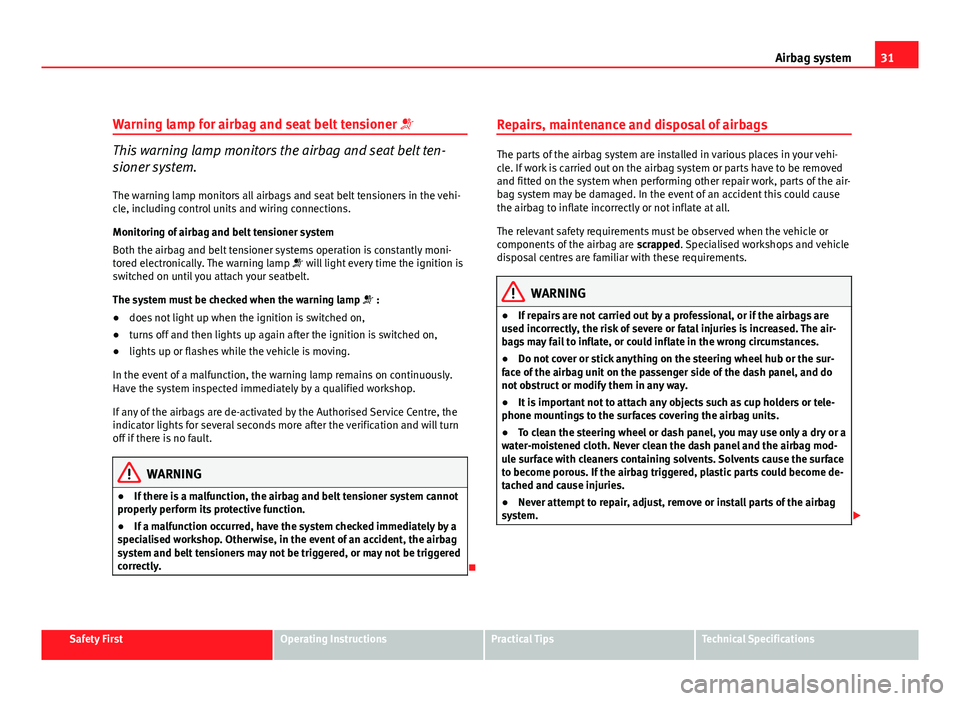
31
Airbag system
Warning lamp for airbag and seat belt tensioner
This warning lamp monitors the airbag and seat belt ten-
sioner system.
The warning lamp monitors all airbags and seat belt tensioners in the vehi-
cle, including control units and wiring connections.
Monitoring of airbag and belt tensioner system
Both the airbag and belt tensioner systems operation is constantly moni-
tored electronically. The warning lamp will light every time the ignition is
switched on until you attach your seatbelt.
The system must be checked when the warning lamp :
● does not light up when the ignition is switched on,
● turns off and then lights up again after the ignition is switched on,
● lights up or flashes while the vehicle is moving.
In the event of a malfunction, the warning lamp remains on continuously.
Have the system inspected immediately by a qualified workshop.
If any of the airbags are de-activated by the Authorised Service Centre, the
indicator lights for several seconds more after the verification and will turn
off if there is no fault.
WARNING
● If there is a malfunction, the airbag and belt tensioner system cannot
properly perform its protective function.
● If a malfunction occurred, have the system checked immediately by a
specialised workshop. Otherwise, in the event of an accident, the airbag
system and belt tensioners may not be triggered, or may not be triggered
correctly.
Repairs, maintenance and disposal of airbags
The parts of the airbag system are installed in various places in your vehi-
cle. If work is carried out on the airbag system or parts have to be removed
and fitted on the system when performing other repair work, parts of the air-
bag system may be damaged. In the event of an accident this could cause
the airbag to inflate incorrectly or not inflate at all.
The relevant safety requirements must be observed when the vehicle or
components of the airbag are
scrapped. Specialised workshops and vehicle
disposal centres are familiar with these requirements.
WARNING
● If repairs are not carried out by a professional, or if the airbags are
used incorrectly, the risk of severe or fatal injuries is increased. The air-
bags may fail to inflate, or could inflate in the wrong circumstances.
● Do not cover or stick anything on the steering wheel hub or the sur-
face of the airbag unit on the passenger side of the dash panel, and do
not obstruct or modify them in any way.
● It is important not to attach any objects such as cup holders or tele-
phone mountings to the surfaces covering the airbag units.
● To clean the steering wheel or dash panel, you may use only a dry or a
water-moistened cloth. Never clean the dash panel and the airbag mod-
ule surface with cleaners containing solvents. Solvents cause the surface
to become porous. If the airbag triggered, plastic parts could become de-
tached and cause injuries.
● Never attempt to repair, adjust, remove or install parts of the airbag
system.
Safety FirstOperating InstructionsPractical TipsTechnical Specifications
Page 35 of 319

33
Airbag system
Front airbags
Description of front airbags
The airbag system is not a substitute for the seat belts.
Fig. 17 Driver airbag in
the steering wheel and
knee airbag in the dash
panel
Fig. 18 Front passenger
airbag located in dash
panel The front airbag for the driver is located in the steering wheel
⇒ fig. 17 and
the airbag for the front passenger is located in the dash panel ⇒ fig. 18. Air-
bags are identified by the word “AIRBAG”. On the driver side, the knee air-
bag* is found in the footwell lining, under the instrument panel.
In conjunction with the seat belts, the front airbag system gives the front
occupants additional protection for the head and chest in the event of a se-
vere frontal collision ⇒ page 36, Safety notes on the front airbag system.
In addition to their normal function of restraining the occupants, the seat
belts also hold the driver and front passenger in a position where the air-
bags can provide maximum protection in a frontal collision.
The airbag system is not a substitute for seat belts, but it is an integral part
of the vehicle's overall passive safety system. Please bear in mind that the
airbag system can only work effectively when the occupants are wearing
their seat belts correctly and have adjusted the head restraints properly.
Therefore, it is most important to wear the seat belts at all times, not only
because this is required by law in most countries, but also for your safety
⇒ page 19, Brief introduction.
The main parts of the front airbag system are:
● an electronic control and monitoring system (control unit)
● the two front airbags (airbag with gas generator) for the driver and front
passenger,
● a knee airbag* for the driver,
● a warning lamp on the instrument panel ⇒ page 31
The airbag system operation is monitored electronically. The airbag warning
lamp will light up for a few seconds every time the ignition is switched on
(self-diagnosis).
There is a fault in the system if the warning lamp :
● does not light up when the ignition is switched on ⇒ page 31
● turns off and then lights up again after the ignition is switched on,
● lights up or flashes while the vehicle is moving.
Safety FirstOperating InstructionsPractical TipsTechnical Specifications
Page 36 of 319
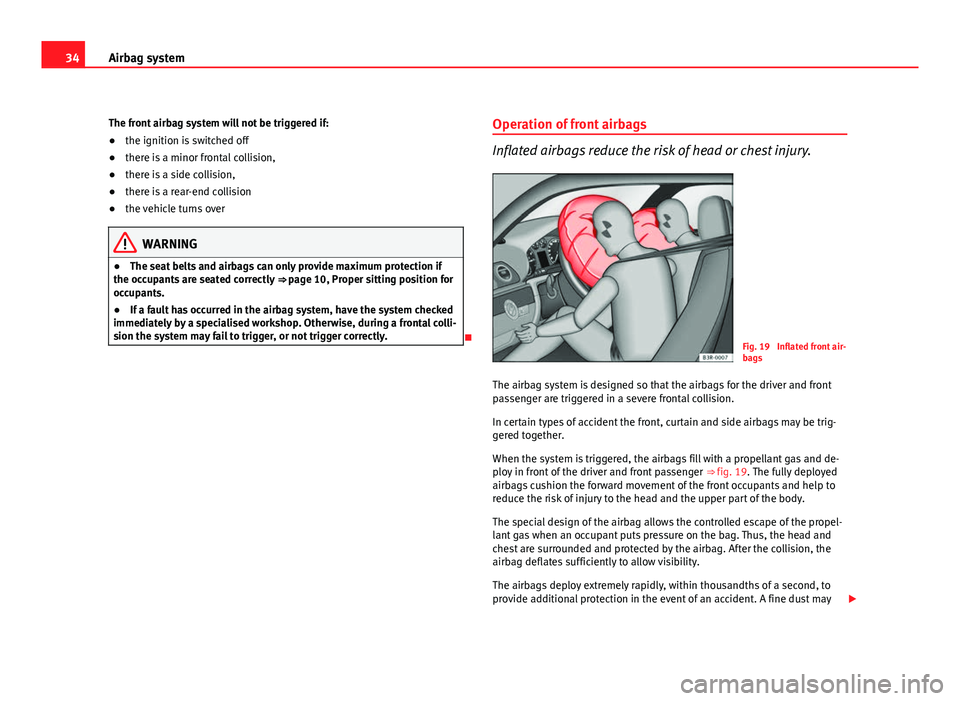
34Airbag system
The front airbag system will not be triggered if:
● the ignition is switched off
● there is a minor frontal collision,
● there is a side collision,
● there is a rear-end collision
● the vehicle turns over
WARNING
● The seat belts and airbags can only provide maximum protection if
the occupants are seated correctly ⇒ page 10, Proper sitting position for
occupants.
● If a fault has occurred in the airbag system, have the system checked
immediately by a specialised workshop. Otherwise, during a frontal colli-
sion the system may fail to trigger, or not trigger correctly.
Operation of front airbags
Inflated airbags reduce the risk of head or chest injury.
Fig. 19 Inflated front air-
bags
The airbag system is designed so that the airbags for the driver and front
passenger are triggered in a severe frontal collision.
In certain types of accident the front, curtain and side airbags may be trig-
gered together.
When the system is triggered, the airbags fill with a propellant gas and de-
ploy in front of the driver and front passenger ⇒ fig. 19. The fully deployed
airbags cushion the forward movement of the front occupants and help to
reduce the risk of injury to the head and the upper part of the body.
The special design of the airbag allows the controlled escape of the propel-
lant gas when an occupant puts pressure on the bag. Thus, the head and
chest are surrounded and protected by the airbag. After the collision, the
airbag deflates sufficiently to allow visibility.
The airbags deploy extremely rapidly, within thousandths of a second, to
provide additional protection in the event of an accident. A fine dust may
Page 38 of 319
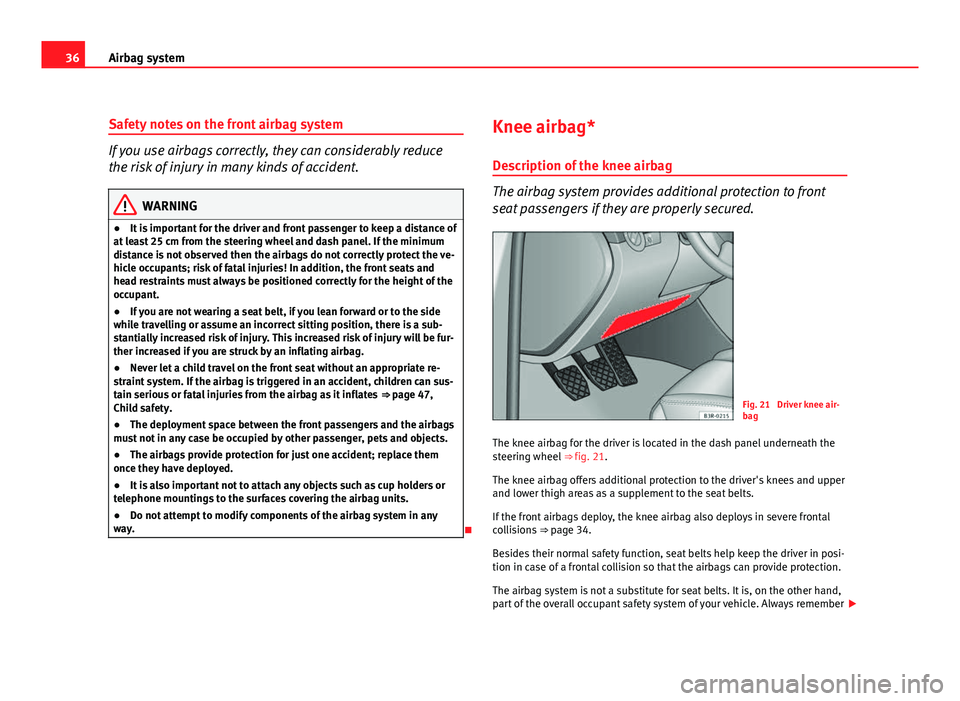
36Airbag system
Safety notes on the front airbag system
If you use airbags correctly, they can considerably reduce
the risk of injury in many kinds of accident.
WARNING
● It is important for the driver and front passenger to keep a distance of
at least 25 cm from the steering wheel and dash panel. If the minimum
distance is not observed then the airbags do not correctly protect the ve-
hicle occupants; risk of fatal injuries! In addition, the front seats and
head restraints must always be positioned correctly for the height of the
occupant.
● If you are not wearing a seat belt, if you lean forward or to the side
while travelling or assume an incorrect sitting position, there is a sub-
stantially increased risk of injury. This increased risk of injury will be fur-
ther increased if you are struck by an inflating airbag.
● Never let a child travel on the front seat without an appropriate re-
straint system. If the airbag is triggered in an accident, children can sus-
tain serious or fatal injuries from the airbag as it inflates ⇒ page 47,
Child safety.
● The deployment space between the front passengers and the airbags
must not in any case be occupied by other passenger, pets and objects.
● The airbags provide protection for just one accident; replace them
once they have deployed.
● It is also important not to attach any objects such as cup holders or
telephone mountings to the surfaces covering the airbag units.
● Do not attempt to modify components of the airbag system in any
way.
Knee airbag*
Description of the knee airbag
The airbag system provides additional protection to front
seat passengers if they are properly secured.
Fig. 21 Driver knee air-
bag
The knee airbag for the driver is located in the dash panel underneath the
steering wheel ⇒ fig. 21.
The knee airbag offers additional protection to the driver's knees and upper
and lower thigh areas as a supplement to the seat belts.
If the front airbags deploy, the knee airbag also deploys in severe frontal
collisions ⇒ page 34.
Besides their normal safety function, seat belts help keep the driver in posi-
tion in case of a frontal collision so that the airbags can provide protection.
The airbag system is not a substitute for seat belts. It is, on the other hand,
part of the overall occupant safety system of your vehicle. Always remember
Page 39 of 319
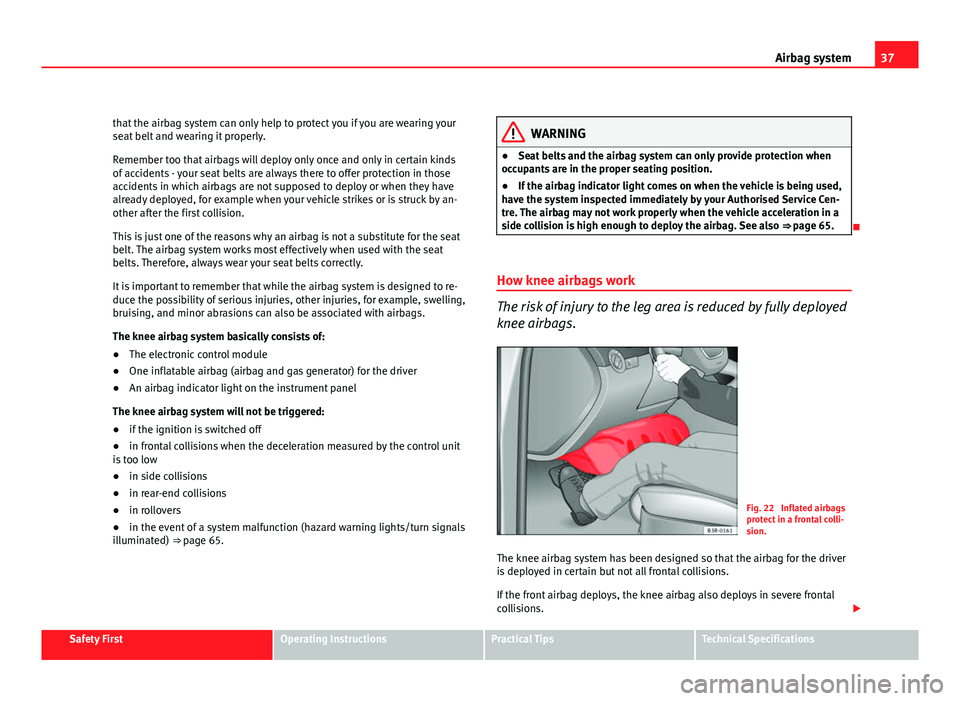
37
Airbag system
that the airbag system can only help to protect you if you are wearing your
seat belt and wearing it properly.
Remember too that airbags will deploy only once and only in certain kinds
of accidents - your seat belts are always there to offer protection in those
accidents in which airbags are not supposed to deploy or when they have
already deployed, for example when your vehicle strikes or is struck by an-
other after the first collision.
This is just one of the reasons why an airbag is not a substitute for the seat
belt. The airbag system works most effectively when used with the seat
belts. Therefore, always wear your seat belts correctly.
It is important to remember that while the airbag system is designed to re-
duce the possibility of serious injuries, other injuries, for example, swelling,
bruising, and minor abrasions can also be associated with airbags.
The knee airbag system basically consists of:
● The electronic control module
● One inflatable airbag (airbag and gas generator) for the driver
● An airbag indicator light on the instrument panel
The knee airbag system will not be triggered:
● if the ignition is switched off
● in frontal collisions when the deceleration measured by the control unit
is too low
● in side collisions
● in rear-end collisions
● in rollovers
● in the event of a system malfunction (hazard warning lights/turn signals
illuminated) ⇒ page 65.
WARNING
● Seat belts and the airbag system can only provide protection when
occupants are in the proper seating position.
● If the airbag indicator light comes on when the vehicle is being used,
have the system inspected immediately by your Authorised Service Cen-
tre. The airbag may not work properly when the vehicle acceleration in a
side collision is high enough to deploy the airbag. See also ⇒ page 65.
How knee airbags work
The risk of injury to the leg area is reduced by fully deployed
knee airbags.
Fig. 22 Inflated airbags
protect in a frontal colli-
sion.
The knee airbag system has been designed so that the airbag for the driver
is deployed in certain but not all frontal collisions.
If the front airbag deploys, the knee airbag also deploys in severe frontal
collisions.
Safety FirstOperating InstructionsPractical TipsTechnical Specifications
Page 41 of 319
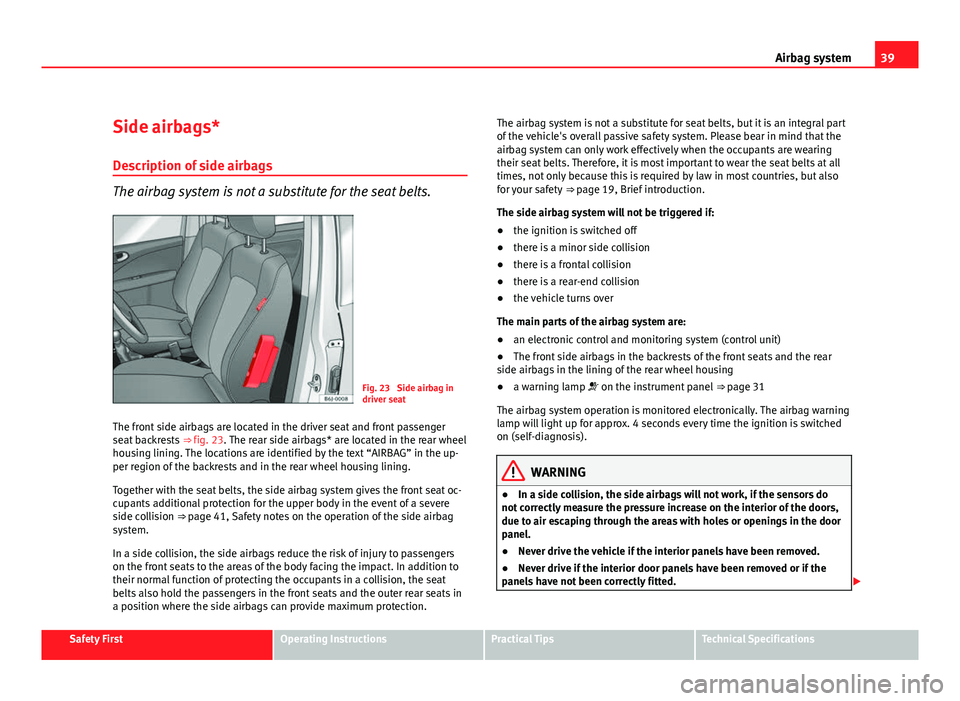
39
Airbag system
Side airbags* Description of side airbags
The airbag system is not a substitute for the seat belts.
Fig. 23 Side airbag in
driver seat
The front side airbags are located in the driver seat and front passenger
seat backrests ⇒ fig. 23. The rear side airbags* are located in the rear wheel
housing lining. The locations are identified by the text “AIRBAG” in the up-
per region of the backrests and in the rear wheel housing lining.
Together with the seat belts, the side airbag system gives the front seat oc-
cupants additional protection for the upper body in the event of a severe
side collision ⇒ page 41, Safety notes on the operation of the side airbag system.
In a side collision, the side airbags reduce the risk of injury to passengers
on the front seats to the areas of the body facing the impact. In addition to
their normal function of protecting the occupants in a collision, the seat
belts also hold the passengers in the front seats and the outer rear seats in
a position where the side airbags can provide maximum protection. The airbag system is not a substitute for seat belts, but it is an integral part
of the vehicle's overall passive safety system. Please bear in mind that the
airbag system can only work effectively when the occupants are wearing
their seat belts. Therefore, it is most important to wear the seat belts at all
times, not only because this is required by law in most countries, but also
for your safety
⇒ page 19, Brief introduction.
The side airbag system will not be triggered if:
● the ignition is switched off
● there is a minor side collision
● there is a frontal collision
● there is a rear-end collision
● the vehicle turns over
The main parts of the airbag system are:
● an electronic control and monitoring system (control unit)
● The front side airbags in the backrests of the front seats and the rear
side airbags in the lining of the rear wheel housing
● a warning lamp on the instrument panel ⇒ page 31
The airbag system operation is monitored electronically. The airbag warning
lamp will light up for approx. 4 seconds every time the ignition is switched
on (self-diagnosis).
WARNING
● In a side collision, the side airbags will not work, if the sensors do
not correctly measure the pressure increase on the interior of the doors,
due to air escaping through the areas with holes or openings in the door
panel.
● Never drive the vehicle if the interior panels have been removed.
● Never drive if the interior door panels have been removed or if the
panels have not been correctly fitted.
Safety FirstOperating InstructionsPractical TipsTechnical Specifications
Page 43 of 319

41
Airbag system
The special design of the airbag allows the controlled escape of the propel-
lant gas when an occupant puts pressure on the bag. Thus, the head and
chest are surrounded and protected by the airbag.
Safety notes on the operation of the side airbag system
If airbags are used correctly, they can considerably reduce
the risk of injury in side impact collisions.
WARNING
● If you do not wear a seat belt, if you lean forward, or are not seated
correctly while the vehicle is in motion, you are at a greater risk of injury
if the side airbag system is triggered in an accident.
● In order for the side airbags to provide their maximum protection, the
prescribed sitting position must always be maintained with seat belts
fastened while travelling.
● Occupants of the outer seats must never carry any objects or pets in
the deployment space between them and the airbags, or allow children
or other passengers to travel in this position. It is also important not to
attach any accessories (such as cup holders) to the doors. This would im-
pair the protection offered by the side airbags.
● The built-in coat hooks should be used only for lightweight clothing.
Do not leave any heavy or sharp-edged objects in the pockets.
● Great forces, such as hard blows or kicks, must not be exerted upon
the backrest bolster because the system may be damaged. In this case,
the side airbags would not be triggered.
● Under no circumstances should protective covers be fitted over seats
with side airbags unless the covers have been approved for use in your
vehicle. Because the airbag is triggered from the side of the backrest, the
WARNING (Continued)
use of non-approved seat covers would obstruct the side airbag, serious-
ly reducing the airbag's effectiveness ⇒ page 220, Accessories, parts re-
placement and modifications.
● Any damage to the original seat upholstery or around the seams of
the side airbag units must be repaired immediately by a specialised
workshop.
● The airbags provide protection for just one accident; replace them
once they have deployed.
● When children assume an incorrect sitting position, they expose
themselves to an increased risk of injury in the event of an accident. This
is particularly the case if the child is travelling on the front passenger
seat and the airbag system is triggered in an accident; this could have
critical consequences including serious injury or death ⇒ page 47,
Child safety.
● Any work on the side airbag system or removal and installation of the
airbag components for other repairs (such as removal of the front seat)
should only be performed by a specialised workshop. Otherwise, faults
may occur during the airbag system operation.
● Do not attempt to modify components of the airbag system in any
way.
● The side and head airbags are managed through sensors located in
the interior of the front doors. To ensure the correct functioning of the
side and head airbags neither the doors nor the door panels should be
modified in any way (e.g. fitting loudspeakers). If the front door is dam-
aged, the airbag system may not work correctly. All work carried out on
the front door must be made in a specialised workshop.
Safety FirstOperating InstructionsPractical TipsTechnical Specifications
Page 44 of 319
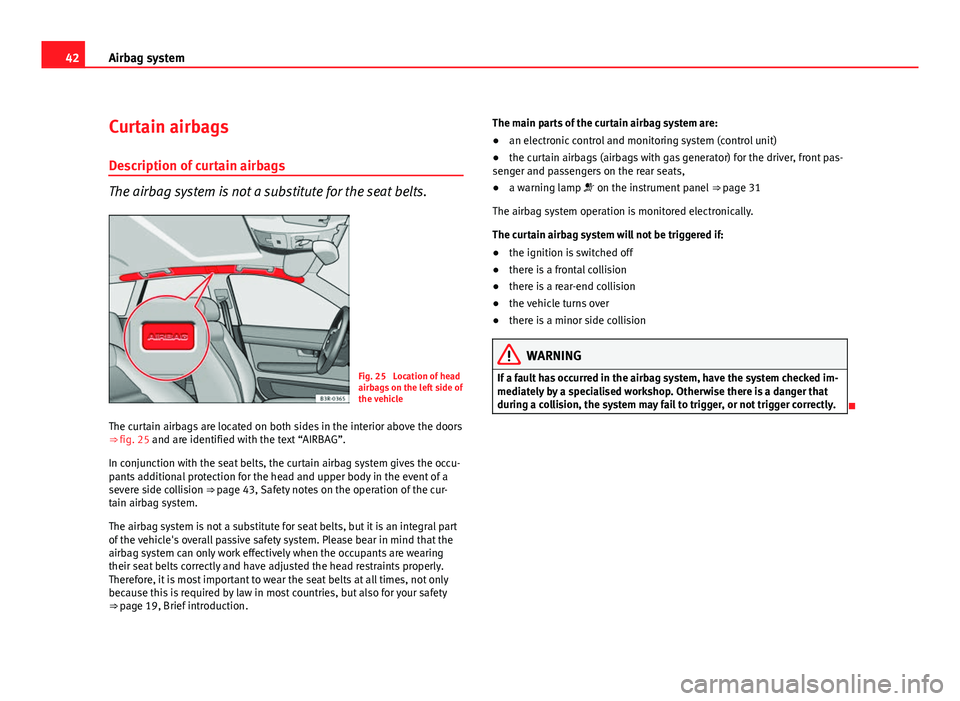
42Airbag system
Curtain airbags
Description of curtain airbags
The airbag system is not a substitute for the seat belts.
Fig. 25 Location of head
airbags on the left side of
the vehicle
The curtain airbags are located on both sides in the interior above the doors
⇒ fig. 25 and are identified with the text “AIRBAG”. In conjunction with the seat belts, the curtain airbag system gives the occu-
pants additional protection for the head and upper body in the event of a
severe side collision ⇒ page 43, Safety notes on the operation of the cur-tain airbag system.
The airbag system is not a substitute for seat belts, but it is an integral part
of the vehicle's overall passive safety system. Please bear in mind that the
airbag system can only work effectively when the occupants are wearing
their seat belts correctly and have adjusted the head restraints properly.
Therefore, it is most important to wear the seat belts at all times, not only
because this is required by law in most countries, but also for your safety
⇒ page 19, Brief introduction. The main parts of the curtain airbag system are:
●
an electronic control and monitoring system (control unit)
● the curtain airbags (airbags with gas generator) for the driver, front pas-
senger and passengers on the rear seats,
● a warning lamp on the instrument panel ⇒ page 31
The airbag system operation is monitored electronically.
The curtain airbag system will not be triggered if:
● the ignition is switched off
● there is a frontal collision
● there is a rear-end collision
● the vehicle turns over
● there is a minor side collision
WARNING
If a fault has occurred in the airbag system, have the system checked im-
mediately by a specialised workshop. Otherwise there is a danger that
during a collision, the system may fail to trigger, or not trigger correctly.